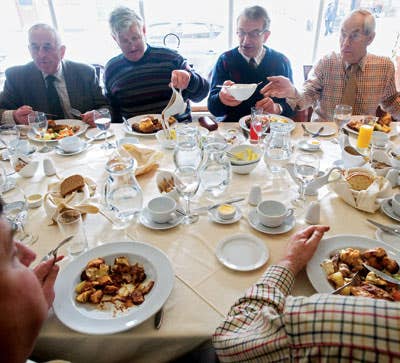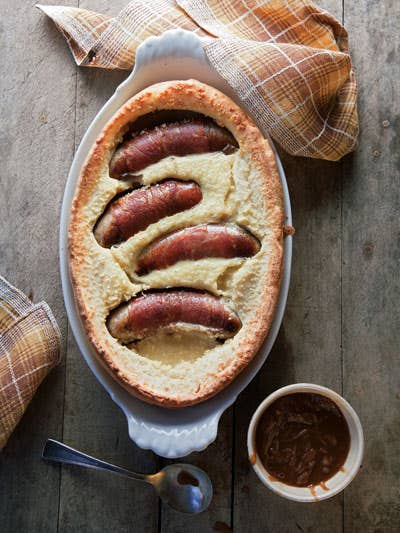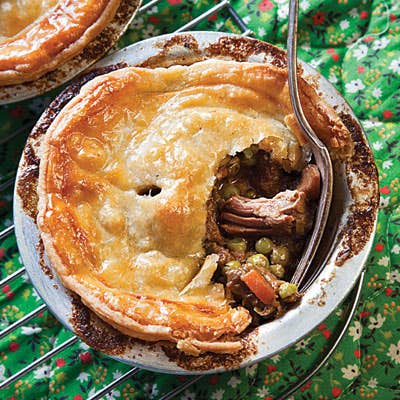
Butchers’ Banquet: England’s Lincolnshire Wolds
In a rural English town, pork pies, sausages, and proper roast dinners are a way of life
No major highway will take you all the way to the Lincolnshire Wolds, an austere, gently undulating landscape at the eastern edge of England. There's an uncanny beauty to the place, remote and sparsely populated as it is. "We're on the road to nowhere, really," was the way Jim Sutcliffe put it to me the last time I visited that part of England.
Sutcliffe is a butcher in Louth (rhymes with "mouth"), also known as the Capital of the Wolds. It's an exceptionally good place to be a butcher, not to mention visit one, with no fewer than five in this small town. Louth's relative isolation has made it a veritable Galapagos of Lincolnshire butchering traditions. I went there to observe the delicate balance of environment, resources, and relationships that allows a distinctive regional cuisine to flourish. And because I love a pork pie.
The name of Sutcliffe's shop is Meridian Meats—as in the Prime Meridian, the line of longitude that runs down one side of the store and through the farm nine miles due south where the Sutcliffe family raises cattle and sheep. The family opened the shop in 2008, after a butcher who'd long occupied the space retired. Sutcliffe is earnest, baby-faced; even so, I was surprised to learn that he's just 25 years old. When I asked why he became a butcher, his answer was both philosophical and practical. "It benefits me on both sides, being a farmer and a butcher," Sutcliffe said. "You spend the best part of two years putting tender loving care into the animal. I know what qualities I need as a butcher—the size and the shape and the cover of the fat. Our animals are slaughtered at a small abattoir very close by. I can monitor all of it." Still a teenager when he decided to seek an apprenticeship, he began in the only way he could think of: by writing letters to all the butchers in Lincolnshire. Finally, Eric Phipps, in the nearby town of Mareham-le-Fen—a butcher so old-school he slaughtered animals in his own abattoir behind his shop—agreed to teach Sutcliffe what he knew.
That included how to cure and stuff a chine, a meaty cut from between the shoulders of the pig that is found only in Lincolnshire. "The native Lincolnshire Curly Coat pig was hellishly fat," Sutcliffe explained of the now-extinct breed. "They'd keep them until they were something like 40 stone [560 pounds], and there would be two or three inches of fat on the back." Once it was slaughtered—typically in cool weather—and hung up overnight, that layer of fat would solidify, making the animal difficult to break down. "They would have looked at it and said, Right, it's easier to cut through the ribs either side of the backbone than it is to cut through the middle of the backbone," Sutcliffe said. After brining, the chine is scored with deep slits, stuffed with chopped parsley, and simmered. Sliced thin and served on buttered bread with malt vinegar, the cured pork striated with herbs is one of the world's great cold cuts.
Steak and Stilton Pies
Pungent Stilton cheese and malty stout beer enrich the filling in these classic Lancashire meat pies. See the Recipe for Steak and Stilton Pies »
At Meridian Meats they also make excellent Lincolnshire sausages, plump links of coarse-ground pork with a sage fragrance so bracing it sets the endorphins firing even as the meat is browning in the pan. They've always been my favorite of the English regional sausages; I like to bake them in a Yorkshire pudding batter to make toad in the hole. There is haslet, too, a pork meat loaf loaded with liver and wrapped in caul fat, which binds the meat and melts into it during cooking. There are cuts of Wolds lamb and well-marbled Lincoln Red beef, as well as Berkshire pork from Sutcliffe's farm and a few of his neighbors'. And there are baked goods, as butchers here are often bakers, too (what with all that extra lard lying around): Lincolnshire plum loaf, lemon drizzle cake, and, oh, those meat pies.
The king of them all, the pork pie, is a magnificent and utterly medieval raised pastry in a rich lard crust with a pork gelatin lining and a core of rustic pork terrine. In fact, the whole shop looked to me like an old Dutch still life—maybe an allegory of abundance and fleeting earthly pleasures—from the fleshy pigs' ears and trotters displayed up front to the jewel-toned jars of mint sauce, red currant jelly, and apple chutney lining the back wall. To the people filing in and out dragging their wheeled carts behind them, it was just another week's shopping.
All of this is not to say that Sutcliffe is not keeping up with the times. He blogs. He posts videos to a Meridian Meats YouTube channel. (My favorite is "Lamb Butchery 1," but "Silent Sausage Making" is pretty great, too.) Still, Louth is a traditional market town, and certain rhythms and routines have persisted since the Middle Ages. To begin to understand the place, you should be there, as I was, on a Wednesday, early. This is market day, when the tidy Georgian red brick town center is given over to rows of stalls selling everything from fresh produce to fish cakes made in the nearby town of Grimsby, on the North Sea. It's an event, and people show up from the surrounding countryside to take part.
The next day, I headed to Louth's weekly livestock market—the last of its kind in Lincolnshire—just a few minutes' walk from the town center. Michael Read keeps a herd of Lincoln Red cows in the River Bain Valley, in the southwestern corner of the Wolds. On the morning he met me, he planned to auction a couple of his cows. Read explained that the Lincoln Red is an animal that reflects the climate and culture of Lincolnshire in its DNA. "Our natives were bred for meat, warmth, milk, and tallow," he told me. "It's why the Lincoln Red has such a fine texture and superb marbling."
We were outside the low-slung redbrick market building, near where the sheep were being auctioned. Farmers wearing tweed caps and thigh-high gaiters milled around the pens, pointing out particularly fine animals with long crooks. It was a convivial scene, and when the auctioneer appeared on a scaffold above the sheep pens to begin the bidding, it was a low-key business all around.
Inside at the cattle auction, the atmosphere was more charged. David Williams, an auctioneer in a white coat, stood on a grandstand overlooking a large pen; an audience of farmers, butchers, and wholesalers crowded around and also looked on keenly from a row of risers. One by one, cows were released into the pen snorting and stomping, and the auctioneer called steadily in his velvety BBC radio announcer-ish voice. "Good bullock here weighing 660. Start at 30. 31, 32, 33—come again—33." Read pointed out to me the subtle signals the bidders were making, sometimes nothing more than a wink, or a lift of a finger; I couldn't imagine how the auctioneer could possibly keep track. "58, 58, 58. 60, then? Oh, I thought you would with a heifer like that."

After the auction, I walked down to Lakings of Louth, a butcher in business since 1908, to meet the 80-year-old proprietor, John Laking. "I bought one beast up at auction today, from Robert Needham," he told me as he led me through the busy store. "His grandfather sold to my grandfather." Behind the shop was a warren of rooms full of people in white trilby hats and aprons, taking apart carcasses with handsaws, baking meat pies. I asked Laking if he'd noticed any effect on his business with the opening of a new supermarket in town. "People around here don't buy meat from a supermarket," was his firm reply. "They know their butcher."
Still, things have changed over the course of Laking's lifetime. When he was born in 1931, there were around five times as many butchers in Louth, and until the mid-1980s, animals were butchered in an abattoir in town. Laking shook his head when he talked about health-conscious trends of the latter part of the 20th century and the demand for leaner meat. "Now we're finding our customers want meat with a bit more finish on it again," he said with some satisfaction.
The following afternoon, Laking joined Michael Read and 10 other local farmers for a weekly lunch that's been going on at least since their fathers' time. In recent years this Friday ritual has taken place at a restaurant called Melanies. Each week, chef-owner Steven Legg roasts a rib of beef raised by one of the farmers and butchered by Laking. An English roast dinner always feels momentous; this one was no exception. The plates were piled with Yorkshire pudding, parsnip mash, and a crisp-fried bubble and squeak made from roasted root vegetables, with boats of beef gravy set at every other place. Anticipation mounted until Legg's wife, Aileen, presented the roast and one of the farmers was designated as carver. "If someone's done well at a livestock show," Legg murmured, "they've been known to have Champagne."
Later that evening, I cooked a little feast of my own in the apartment where I was staying. The centerpiece was a thick steak of Lincoln Red beef Jim Sutcliffe had cut for me earlier that day. "You have to respect this process right through," he told me. "Somebody's calved that cow on a wet night at 2 A.M. It's sacrificed its life to feed us." Seared in a blazing hot skillet, the meat was deep red and intensely flavorful, with a buttery texture and—just as I'd been promised—a generous marbling of scrumptious fat. I've never had another steak like it.
Keep Reading
Continue to Next Story











